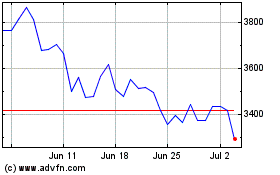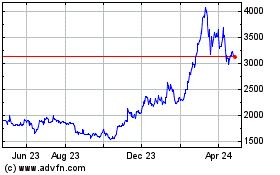Bitcoin Wallets Bleed: 730K Investors Exit Despite Record $7 Billion ETF Inflows
February 23 2024 - 1:35AM
NEWSBTC
The long-awaited arrival of spot Bitcoin ETFs has ignited a gold
rush in the crypto world, attracting both newcomers and seasoned
investors. While these new investment vehicles offer a convenient
and accessible way to gain exposure to Bitcoin, their impact on the
cryptocurrency’s core principles and long-term stability remains a
complex question. Related Reading: Green Bitcoin: Sustainable
Energy Usage Surges To Record 55% High Bitcoin ETF: Initial Surge,
But Ownership Shift A Concern The data paints a fascinating
picture. Following the SEC’s approval of 11 ETFs, the number of
non-zero Bitcoin wallets initially soared, reaching a peak of
nearly 53 million in January. This surge was likely fueled by the
accessibility and security offered by ETFs, attracting individuals
previously hesitant to directly engage with the intricacies of
crypto wallets and exchanges. However, according to data provided
by Santiment, a concerning trend emerged 30 days later: nearly
730,000 fewer wallets held any Bitcoin, suggesting a potential
shift towards holding through ETFs instead of directly owning the
tokens. This raises questions about the long-term impact on
Bitcoin’s decentralized nature and the potential for decreased
on-chain activity. 📊 There are 729.4K less #Bitcoin wallets holding
greater than 0 $BTC, compared to one month ago. After the #SEC
approved 11 Spot Bitcoin #ETF‘s, this amount of non-0 wallets
peaked on January 20th at 52.95M. This is attributed to the
increased interest in #hodlers (Cont) 👇 pic.twitter.com/FThtSDOmk0
— Santiment (@santimentfeed) February 21, 2024 ETF Boom, But
Supply/Demand Dynamics Unchanged While the ETF market is thriving,
its impact on Bitcoin’s core principles is less clear. The recent
record volume and inflows exceeding $7 billion across the top 7
ETFs highlight strong market interest and the potential for
mainstream adoption. Source: Santiment However, it’s crucial to
remember that these ETFs can hold both actual Bitcoin and futures
contracts. This means investors gain exposure without directly
impacting the underlying supply or demand of the cryptocurrency
itself. This raises questions about whether ETFs are truly driving
adoption or simply creating a derivative-based market with its own
set of risks and dynamics. Speculation Surges, Raising Red Flags
Perhaps the most concerning trend is the surge in speculative
trading using derivatives. Open interest on centralized exchanges,
particularly for Bitcoin, has reached unprecedented levels,
exceeding $10 billion for the first time since July 2022. BTC
market cap remains in the $1 trillion region. Chart:
TradingView.com This indicates investors are taking on more risk by
leveraging derivatives, potentially fueled by the “crowd euphoria”
surrounding Bitcoin and the allure of potentially quick gains. This
echoes the speculative frenzy seen in 2017, raising concerns about
potential market volatility and potential crashes. Ethereum,
Solana, and Chainlink also exhibit significant open interest,
suggesting broader market-wide trends beyond just Bitcoin. Related
Reading: Apecoin Climbs To 6-Month High Amidst Whales’ Strategic
Moves The Verdict: A Double-Edged Sword The arrival of spot Bitcoin
ETFs has undoubtedly opened doors for new investors, but it’s
important to acknowledge the potential downsides. While
accessibility has increased, direct ownership might be decreasing,
and the rise of speculative trading using derivatives raises
concerns about future market stability. Moving forward, it will be
crucial to monitor how these trends evolve and their long-term
impact on the overall health of the crypto ecosystem. Additionally,
ongoing regulatory developments surrounding ETFs and derivatives
could further shape the landscape. Featured image from Nicola
Barts/Pexels, chart from TradingView
Ethereum (COIN:ETHUSD)
Historical Stock Chart
From Oct 2024 to Nov 2024

Ethereum (COIN:ETHUSD)
Historical Stock Chart
From Nov 2023 to Nov 2024
